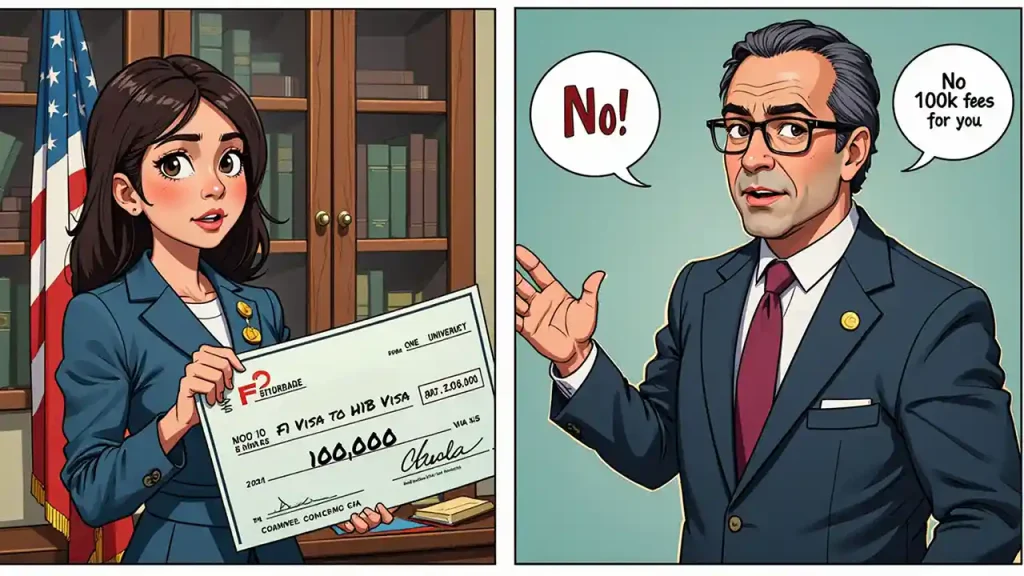
GMAT Newsletter Subscribe
Enter your email address below and subscribe to our newsletter

Enter your email address below and subscribe to our newsletter

If you’ve been scrolling through social media or reading news headlines lately, you’ve probably come across alarming stories about H1B visa changes in the United States. The headlines scream about a new $100,000 H1B Visa fees, tightening immigration policies, and an increasingly difficult path to working in America after completing your MBA.
For international students planning to pursue business school in the US, these stories can be deeply unsettling. You might be asking yourself: “Should I still apply to US business schools? Is my dream of working in America after my MBA still feasible? Should I look at other countries instead?”
Before you make any hasty decisions based on panic or incomplete information, let’s take a deep dive into what’s actually happening with the H1B visa system and—here’s the important part—why this policy change might actually work in your favor if you’re planning to study in the US.
Starting September 21, 2025, the US government implemented a new policy requiring employers to pay a $100,000 filing fee when applying for H1B visas for employees who are located outside the United States.
Let’s be clear about a few critical points:
The policy is real, it’s official, and it’s already in effect. But here’s where most people stop reading and start panicking—and that’s a mistake.
The key phrase in this policy is: “employees who are outside the United States.”
This seemingly small detail makes all the difference for international students. Here’s what it means:
The $100,000 fee applies to:
The $100,000 fee DOES NOT apply to:

If you’re pursuing an MBA in the United States on an F1 student visa, you already have legal status in the country. When you transition from your F1 visa (or your post-graduation OPT period) to an H1B work visa, you’re not applying from outside the US—you’re changing your status within the American immigration system.
This distinction is everything. You are completely exempt from the $100,000 fee.
Now that we understand who is and isn’t affected, let’s explore why this policy might actually improve your prospects as an MBA candidate in the US.
Put yourself in the shoes of a US employer looking to hire talent for a specialized role. They have two candidates with similar qualifications:
Under the new policy, hiring Candidate B would cost the company an additional $100,000 in filing fees. Hiring Candidate A (you!) costs nothing extra.
Which candidate do you think the employer will prefer?
All else being equal, companies will naturally gravitate toward hiring talent already in the US on student visas because it’s significantly more cost-effective. This policy gives you a substantial advantage over equally qualified candidates applying from abroad.
To understand this advantage, you need to know how the H1B system works:
The problem? Large outsourcing companies and recruiters would file thousands of H1B applications for candidates abroad, flooding the system and reducing everyone’s odds of selection.
With the $100,000 filing fee for overseas candidates, mass filings by large recruiting agencies will dramatically decrease. When the total number of H1B applications drops while the number of available visas remains the same, your odds of winning the lottery increase substantially.
Translation: As an MBA student in the US, your chances of securing an H1B visa are now better than they’ve been in years.
Consider this timeline: If you’re applying to business schools now, you’ll be starting your program in 2026. That means you’ll graduate and enter the job market in 2027 or 2028—24 to 30 months from now.
History shows us that economic cycles and job markets fluctuate. Consider these recent examples:
The pattern? Entering business school during uncertain times often means graduating when conditions have improved. Economic cycles don’t last forever, and the two years you spend in your MBA program provide a buffer that often works in your favor.

Sign up for a demo class at https://wzko.in/demo, and begin your GMAT Preparation now!
This is the million-dollar question (or rather, the hundred-thousand-dollar question).
The short answer: Yes.
Companies understand the nuances of this policy. Large corporations know that sponsoring H1B visas for students already in the US on F1 visas doesn’t trigger the $100,000 fee. They’re continuing their sponsorship programs because:
It’s important to be realistic: The US job market isn’t as robust as it was 12-18 months ago. Tech companies aren’t hiring at the same pace. There is uncertainty.
However, these challenges exist regardless of visa policies. They’re market conditions you’d face whether you were an American citizen or an international student. The H1B policy change doesn’t create these challenges—it’s a separate issue.
Moreover, larger companies with established recruiting programs continue to hire and sponsor visas. Startups and smaller companies have always faced more challenges with H1B sponsorship due to resource constraints, and that reality hasn’t changed.
Given all this information, what should you actually do? Here’s a practical, strategic approach:
Despite the headlines, the United States remains the gold standard for MBA education:
Completely removing the US from your business school list based on this H1B fee would be an overreaction to a policy that actually doesn’t apply to you.
Instead of putting all your eggs in one basket (regardless of which country), create a balanced application strategy:
Plan A: Apply to 2-3 US Business Schools Target programs where you’re competitive and that align with your career goals. Remember that you have the $100K advantage we discussed.
Plan B: Apply to 2-3 European Business Schools Programs in the UK, France, Spain, and Switzerland offer excellent education and post-study work opportunities. Brexit has changed UK immigration somewhat, but options remain strong.
Plan C: Apply to 1-2 Asian Business Schools Singapore, Hong Kong, and India (ISB, IIMs) offer strong programs with robust regional recruiting.
Total Portfolio: 6-8 Schools
This diversification ensures you’ll have options next March when admission decisions come in.
When you receive your admissions decisions with scholarship offers, evaluate them using this framework:
Return on Investment (ROI) = Post-MBA Earnings ÷ Total Investment
The numerator (your future earnings) varies by geography and industry. The denominator (your investment) is where scholarships make a huge difference.
Here’s a practical approach: Decide in advance the maximum you’re willing to invest in a US MBA. A reasonable benchmark is to cap it at what you would spend for a top Indian business school like ISB—approximately 50 lakh rupees (about $60,000 USD).
The Logic: If a US business school offers you enough scholarship that your total investment is comparable to ISB, it’s essentially a no-lose proposition:
Worst-case scenario: You graduate and return to India. You’ll find a job comparable to what you’d have gotten with an ISB degree—but with far superior international exposure, a more diverse network, and global work experience.
Best-case scenario: You secure employment in the US, gaining valuable international experience, higher compensation, and career acceleration opportunities unavailable in India.
Either way, you win.

Even if H1B visa scenarios play out in unpredictable ways, the experience of earning an MBA at a top US business school offers intrinsic value:
US business schools attract students from 60-80 countries. You’ll learn alongside military veterans, tech entrepreneurs, consultants, artists, and engineers from every corner of the globe. This diversity creates a learning environment impossible to replicate elsewhere.
The case method, group projects, and classroom discussions at American business schools push you to think beyond your home country’s business practices and cultural norms. This global mindset is invaluable in today’s interconnected economy.
Your MBA cohort becomes your professional network for decades. A diverse, international network opens doors regardless of where your career takes you.
Living and studying abroad stretches you in ways that go far beyond academics. The confidence, independence, and cultural intelligence you develop are career assets that no policy change can diminish.
Let’s acknowledge some legitimate concerns you might have:
Large companies have legal and practical reasons to continue recruiting internationally. They need diverse talent, and they’ve built sophisticated recruiting infrastructures around business schools. The F1 to H1B pathway remains intact and, as we’ve discussed, actually becomes more attractive to employers under this policy.
Tech sector adjustments are cyclical. Moreover, MBA graduates aren’t only employed in tech. Consulting, finance, healthcare, consumer goods, and dozens of other industries actively recruit MBAs. Don’t let one sector’s temporary challenges dictate your entire career strategy.
Immigration policies fluctuate with political cycles, but the economic need for skilled talent remains constant. Businesses drive demand for international workers because they need the best people, regardless of nationality. That fundamental reality hasn’t changed.
As you finalize your business school application strategy, consider these questions:
Your answers to these questions should guide your application strategy more than any single policy change.
The $100,000 H1B filing fee is real, but for international students on F1 visas pursuing MBAs in the United States, it doesn’t apply. In fact, this policy creates a competitive advantage by making you more attractive to employers compared to candidates applying from abroad and by reducing your competition in the H1B lottery.
Should you still pursue your MBA in the US? If it aligns with your career goals, you can afford it (especially with scholarships), and you’re prepared to navigate the visa system—absolutely yes.
But should the US be your only option? No. Diversify your applications across geographies. Apply to strong programs in the US, Europe, and Asia. Give yourself options, and next March, when you have admission offers and scholarship information in hand, you can make an informed decision based on complete information rather than incomplete headlines.
The key is to move forward strategically, not react emotionally. Understand the actual policies, assess your personal situation realistically, and remember that your MBA journey is about much more than any single immigration rule.
The door to US business schools remains open—and for F1 students, it might have just become easier to walk through.
Q: When does the $100,000 H1B fee take effect?
A: The fee went into effect on September 21, 2025.
Q: Do I have to pay the $100,000 fee if I’m on an F1 visa?
A: No. The fee only applies to candidates outside the US. F1 visa holders are exempt because they’re changing status within the US.
Q: Will companies stop hiring international MBA students?
A: No evidence suggests this. Companies understand that the fee doesn’t apply to F1 to H1B transitions and continue recruiting from business schools.
Q: How does this affect my H1B lottery odds?
A: Positively. The fee will reduce total H1B applications, improving your odds of selection in the lottery.
Q: Should I only apply to US business schools?
A: No. Diversify your applications across US, European, and Asian schools to maximize your options.
Q: What if I can’t secure H1B after graduation?
A: You have OPT (12-36 months depending on your field) to work while attempting H1B. If unsuccessful, your US MBA still holds tremendous value globally and in your home country.
Ready to start your MBA journey? Don’t let misinformation derail your dreams. Research schools, prepare your applications, and remember—the $100K H1B fee doesn’t apply to you.
The experienced team comprising top business school graduates at Wizako are available to help you successfully navigate through your MBA journey. Reach out to us on WhatsApp at +919500048484.